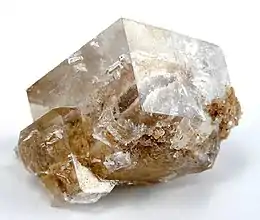Inyoite
Inyoite, named after Inyo County, California, where it was discovered in 1914, is a colourless monoclinic mineral. It turns white on dehydration. Its chemical formula is Ca(H4B3O7)(OH)·4H2O or CaB3O3(OH)5·4H2O.[2]
| Inyoite | |
|---|---|
 | |
| General | |
| Category | Nesoborates |
| Formula (repeating unit) | CaB3O3(OH)5·4H2O |
| Strunz classification | 6.CA.35 |
| Crystal system | Monoclinic |
| Crystal class | Prismatic (2/m) (same H-M symbol) |
| Space group | P21/a |
| Unit cell | a = 10.63, b = 12.06 c = 8.4 [Å]; β = 114.03°; Z = 4 |
| Identification | |
| Colour | Colourless, white on dehydration. |
| Crystal habit | Commonly as prismatic to tabular crystals; also in cockscomb aggregates of pseudorhombohedral crystals; coarsely spherulitic or granular |
| Cleavage | Good on {001}, distinct on {010} |
| Fracture | Irregular/uneven |
| Tenacity | Brittle |
| Mohs scale hardness | 2 |
| Lustre | Vitreous |
| Specific gravity | 1.875 |
| Optical properties | Biaxial (-) |
| Refractive index | nα = 1.495 nβ = 1.505 - 1.512 nγ = 1.520 |
| Birefringence | Maximum δ = 0.025 |
| Dispersion | Weak |
| References | [1][2] |
This article is issued from Wikipedia. The text is licensed under Creative Commons - Attribution - Sharealike. Additional terms may apply for the media files.